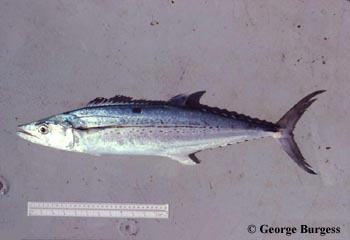
Scomberomorus regalis
This solitary torpedo-shaped fish is streamlined and strong, with finlets running between the prominent second dorsal and anal fins, and the crescent caudal (tail) fin. It is a green-blue from above, and mostly silvery white except for brassy spots and streaks on its sides near the bronze stripe that runs the length of its body. It prefers the warm coastal surface waters of the Western Atlantic where it hunts smaller fish and grows to around 30 inches long. It’s a popular sport fish because of its speed and agility, and a good food fish.
Order – Perciformes
Family – Scombridae
Genus – Scomberomorus
Species – regalis
Common Names
Cero mackerel (English), cero (English), kingfish mackerel (English), carite (Spanish), carite chinigua (Spanish), carite rey (Spanish), carito (Spanish), caval-branca (Portuguese), königsmakrele (German), makrela krowleska (Polish), pintada (Spanish), serra-malhada (Portuguese), sierra (Spanish), thazard atlantique (French), thazard franc (French), and zapadnoatlanticeskaya makrel (Russian).
Importance to Humans
While the cero mackerel is of only minor commercial importance, it is a popular game fish. The cero is caught commercially with gillnets and on lines throughout the Caribbean, especially in the Bahamas and the West Indies. Sport fishers often take this mackerel by trolling with cut bait. The cero mackerel is easily confused with the king mackerel and the Spanish mackerel by fishers. It is a good food fish, marketed fresh, smoked, and frozen and prepared for consumption pan-fried, broiled, or baked.
Danger to Humans
There have been reports of ciguatera poisoning from human consumption of this fish. Ciguatera poisoning occurs when humans eat a fish that has eaten a toxin that is produced by the dinoflagellate, Gambierdiscus toxicus. This poisoning, although it is usually self-limiting, can affect humans in many ways. It has gastrointestinal, neurological, and cardiovascular symptoms. Although often observed swimming toward scuba divers and snorkelers, this fish rarely comes very close.
Conservation
This mackerel is not listed as endangered or vulnerable with the World Conservation Union (IUCN). The IUCN is a global union of states, governmental agencies, and non-governmental organizations in a partnership that assesses the conservation status of species.
> Check the status of the cero mackerel at the IUCN website.
Geographical Distribution
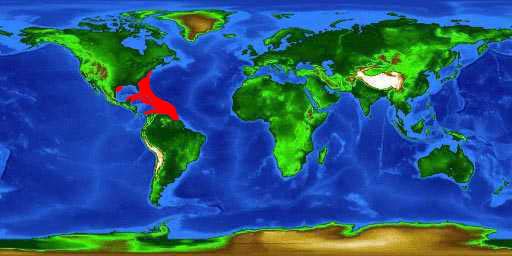
The range of the cero mackerel is limited to the western Atlantic Ocean, from Massachusetts, USA south to Brazil, including the Bahamas and West Indies. It is common in the Caribbean, Bahamas, and Florida.
Habitat
Usually solitary, the cero mackerel occasionally forms schools over coral reefs, wrecks, and along ledges at depths ranging from 3.3-66 feet (1-20 m). It is usually seen in mid-water and near the water’s surface.
Biology
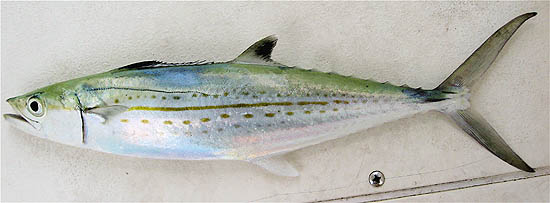
Distinctive Features
The elongate, streamlined body of the cero mackerel is well-adapted for swimming at speeds up to 30 mph (48 kph). The body is covered with small scales, with the lateral line sloping downwards toward the caudal peduncle. Another similar fish, the king mackerel, can be distinguished from the cero mackerel as it has a lateral line that curves downward below the second dorsal fin. The caudal fin is lunate and the pelvic fins are relatively long. Scales extend out onto the pectoral fins. This characteristic distinguishes it from the king mackerel and the Spanish mackerel, two scombrids lacking scales on the pectoral fins. The spiny and soft dorsal fins are separate, with the soft dorsal fin matching the anal fin directly below it. There are a series of finlets following each fin as well as three keels on either side of the caudal peduncle. The swim bladder is absent in the cero mackerel. Although, the cero is often confused with the Spanish mackerel, there are three main differences between the two species. Firstly, the cero has an elongate posterior pelvic process. Secondly, there is a difference in the circulatory system, where the cero has a coeliaco-mesenteric shunt, and the Spanish mackerel does not. Lastly the cero does not have a pterotic spine.
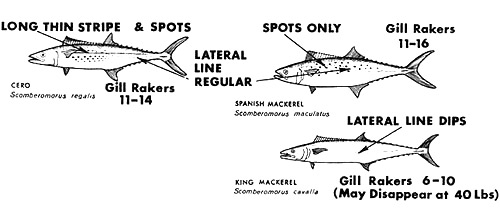
Coloration
The back is iridescent bluish-green with the sides and belly silvery in color. A mid-lateral bronze stripe runs from the pectoral fin to the base of the caudal fin. There are several rows of yellow-orange streaks along with yellow spots forming lines above and below the lateral stripe. The anterior third of the first dorsal fin is bluish-black.
The spot pattern on the sides of the body along with the bluish-black coloration of the anterior dorsal fin and the scaled pectoral fins all separate this fish from the Spanish mackerel, S. maculatus, and the king mackerel, S. cavalla. The anterior portion of the dorsal is not black in the king mackerel except in young individuals. The Spanish mackerel, by contrast, has spots along its sides similar to the cero mackerel, however it lacks longitudinal stripes as well as the yellow-orange streaking pattern.

Dentition
The cero mackerel is well-equipped for prey capture with powerful jaws and razor-sharp teeth.
Size, Age, and Growth
The cero mackerel grows to a maximum size of 72 inches (183 cm) in length and 17 pounds (7.76 kg) in weight. The record in Florida waters is 15.5 pounds (7 kg), although the fish commonly weighs up to 8 pounds (3.6 kg). Males reach maturity at lengths between 12.8-13.4 inches (32.5-34 cm), and females at lengths of approximately 15 inches (38 cm).
Food Habits
This swift, shallow water predator feeds primarily on clupeioid fish including herrings as well as silversides of the genus Allanetta. The diet of the cero mackerel also includes squid and shrimp.
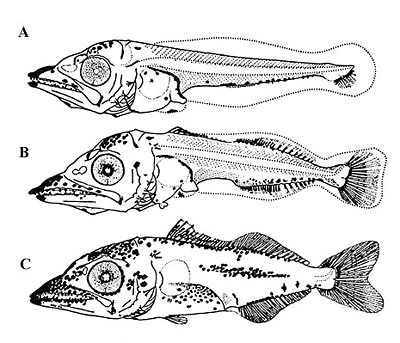
Reproduction
Spawning occurs offshore during April through October off Jamaica, and year round off the coast of Florida, Puerto Rico, and Venezuela. Females between 15-31 inches (38-80 cm) release from 160,000 to 2.23 million eggs each. This species has oviparous, buoyant eggs and pelagic larva.The eggs are usually 0.046-.048 inches (1.16-1.22 mm) in diameter and hatch at 0.013-0.014 inches (0.34-0.36 mm). During development of the larva, the caudal fin appears first, and is followed by the development of the first dorsal, second dorsal, anal, and lastly the pectoral pelvic fin.
Predators
Predators of the cero mackerel include wahoo (Acanthocybium solandri), sharks, dolphins, and diving sea birds. The silvery color of the underside of this fish blends in well with the glow from the sun shining on the surface of the water, making it difficult to detect for predators threatening from below. On the other hand, the dark coloration of the cero mackerel’s back blends in with the blue-green color of the sea, making it difficult to spot from a bird’s view.
Parasites
The cero mackerel hosts 21 documented parasites. Among these parasites is the copepod Brachiella thynni, which is found on the fins of this fish. Other parasitic copepods are Caligus bonito and Caligus productus which occur on the body surface and on the wall of the branchial cavities, as well as Pseudocycnoides buccata which occurs as a parasite on the gill filaments.
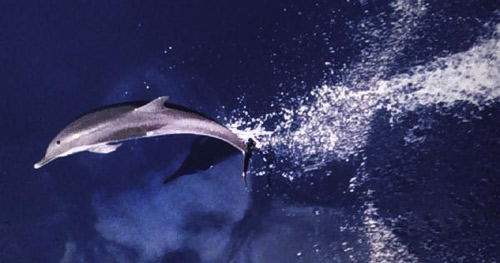
Other parasites include protozoans, digenea (flukes), didymozoidea (tissue flukes), monogenea (gillworms), cestoda (tapeworms), nematoda (roundworms), and isopods.
Taxonomy
Bloch described the cero mackerel as Scomberomorus regalis in 1793. The genus Scomberomorus is derived from the Latin word “scomber” = mackerel and the Greek word “moros” = silly, stupid. Regalis is from the Latin language, meaning royal. Scomberomorus plumierii Lacepede 1803 and Cybium regale Cuvier 1829 are synonyms referring to this species. The family Scombridae includes tunas, mackerels, and bonitos, all swift predators of tropical and subtropical open seas. They are among the most important of the commercial and sport fishes.
Prepared by: Tina Perrotta and Cathy Bester